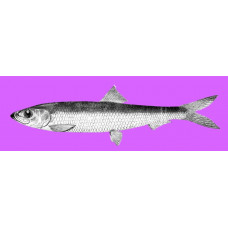Latin name
Clupea pallasii marisalbi
Other name
Clupea harengus pallasi n. marisalbi Berg, Clupea pallasii marisalbi Berg.
Identification
The head of the White Sea herring is at least 21% of the body length. The number of vertebrae is small, mostly 53-54, varying from 50 to 56. The number of gill rakers is 60 to 73. Behind the pelvic fins there are usually 11-13 keel scales (most often 12, varying 10-14). Keel scales are usually more or less distinct only behind the pelvic fins. The vomer armament is weak. Eyes are larger than in subspecies Clupea pallasii pallasii, their diameter is more than 23% of head length (in Pacific herring - up to 22%). It differs from the Atlantic herring, whose range partially overlaps with the White Sea herring, by its coloration and smaller number of vertebrae.
Features of fish fins
In dorsal fin 16-22 rays (counting all rays together, unbranched and branched), mostly 18, 19; in anal fin 13-19 rays (counting all rays together), mostly 17; in pelvic fin mostly 9. In percent of absolute body length (average): length of pectoral fin 12.9, length of pelvic fin 8.6.
Fish colouring
White Sea herring are bluish-green on the back and silvery white on the sides and belly.
Distribution
This species is widespread in the White Sea and adjacent parts of the Barents Sea.
Habitat
In the White Sea, they inhabit mainly its coastal part and bays. Herring are not found in the central areas of the sea.
Size
White sea herring have a body length of about 35 cm. They have a low growth rate. They live up to 7-8 years. A distinction is made between small and large races.
Behavior
White Sea herring are tied to bays throughout the year. In winter, the temperature of the brackish water near the rivers is much higher than that of the sea water; in spring, the water is stratified by desalination and the surface water warms up faster. In summer, the coastal waters of the White Sea are much richer in plankton. Such attachment of White Sea herring to bays determines the division of this subspecies into separate races.
Food and feeding habits
Euphausiidae (Thysanoessa), Hyperiidae (Themisto), Calanoida (Metridia, Acartia, Calanus, Pseudocalanus, etc.), to a lesser extent - Mysidae, Decapoda, Sagitta, Pteropoda larvae, fish fry (Gasterosteus, Lumpenus, capelin) are the most important in the diet of White Sea herring.
Reproduction
Small herring reach sexual maturity in their second and third years of life, while large herring reach maturity in their fourth and fifth years. Spawning takes place either at the end of the winter, still under ice, or in the spring, when the coastal areas are cleared of ice. Spawning grounds are located at depths of up to 1-2 meters. Herring lay their eggs on eelgrass. Due to low temperatures, often below 0°C at the beginning of development, egg development can take up to 30 or even 50 days. Small herring spawn earlier, in April-May, while large herring spawn later, approaching the shore when the water temperature rises to 5°C in May-June.
Fishing
This species is commercially important for fishing. By the size of its catches it ranks first among other fish in the White Sea. It is caught in spring and autumn near the coast (in the open sea fishing is poorly developed) with shuttle seines, and sometimes the locks are used effectively.
Relationship with a person
Harmless. It is eaten smoked, canned, salted and lightly salted.
| Classification | |
| Phylum | Chordata |
| Class | Actinopterygii |
| Squad | Clupeiformes |
| Family | Clupeidae |
| Genus | Clupea |
| Species | C. pallasii |
| Features | |
| Conservation status | Not Evaluated |
| Habitat | Pelagic |
| Life span, years | 8 |
| Maximum body weight, kg | No information |
| Maximum length, cm | 35 |
| Sailing speed, m/s | No information |
| Threat to people | Edible |
| Way of eating | Predator |
White Sea herring
Tags: white sea herring

